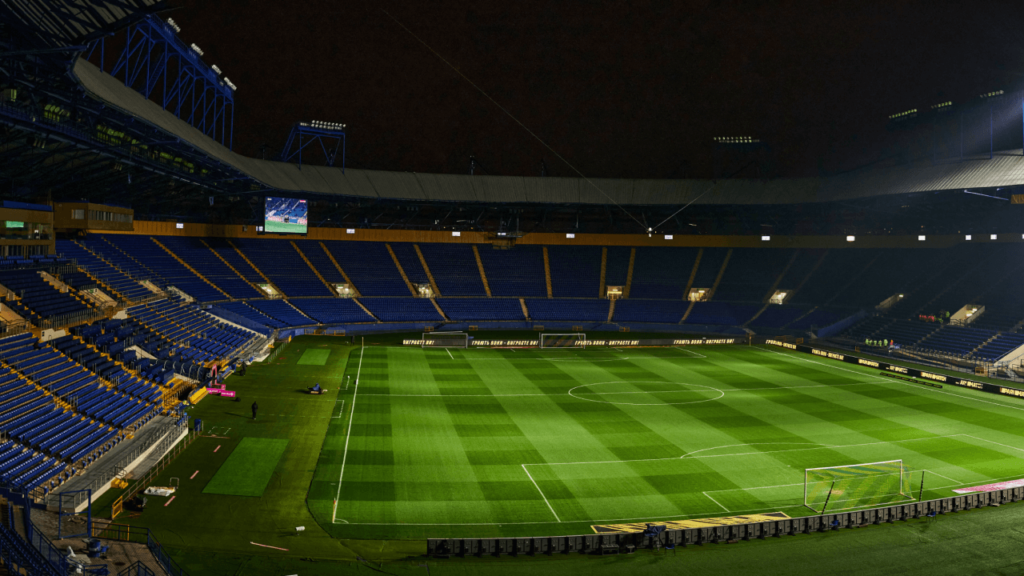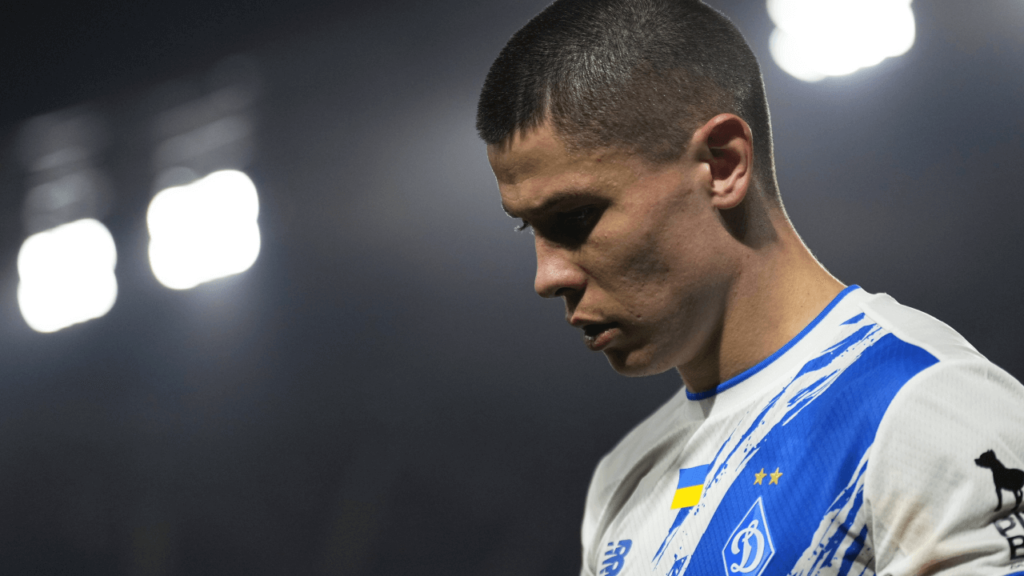Ukraine’s fight on the footballing front
On the 26th of February this year, Metalist 1925 were due to play Shakhtar Donetsk to mark the end of the Ukrainian Premier League’s winter break and the beginning of the second half of the 2021/22 season. The Kharkiv-based club had played a few friendlies across Europe in preparation for this game but were back at home base a number of days prior to this fixture. As the day of the match came ever closer, excitement was building, but suddenly, with two days to go, everyone completely forgot about the game.
By Neel Shelat
On the 24th of February, Russia launched an invasion of Ukraine. Located just about 40 kilometres away from the Russian border, Kharkiv was one of the first major Ukrainian cities that was targeted, so all the players and staff members of Metalist 1925 were forced to evacuate the city alongside hundreds of thousands of other civilians.

Pavlo Posokhov, press officer at Metalist 1925, recalled that day when we spoke to him:
“On the morning of the 24th, we all woke up at about 4 or 5am because Russia was bombing Kharkiv. We all understood what was going on around us, and everyone tried to save their families and themselves, and most of the people went to the West, away from the border on the East.”
Thankfully, everyone from the club managed to escape safely. Unfortunately, the same cannot be said about all the citizens of Kharkiv, and indeed most other cities affected by Russian attacks, as countless lives were lost on that day and throughout the war.
Recently, there has been a lot of discussion about the role of politics in the sport of football, with many calling for the two to be kept separate. The reality, however, is that the two have always been intrinsically linked, because there is much more to football than just 22 people chasing a ball around a field of grass. As with all things in life, this is both good and bad in certain cases.
Take, for example, the role of football in Russia’s invasion of Ukraine. Many experts have said that Russia has used football as a means to accumulate soft power over the years, both in a subtle fashion such as through sponsorship deals for state-backed brands like Gazprom and in a more blockbuster fashion such as during the 2018 FIFA World Cup.
Of course, Russia’s invasion had a major impact on the footballing scene in the country. The national team was barred from participating in international competitions like the UEFA Nations League and 2022 FIFA World Cup, while clubs were chucked out of UEFA competitions, leading to a mass exodus of foreign players from the Russian Premier League.
However, a significantly more profound effect was felt in Ukraine, where there were more pressing matters at hand than football, so the sport came to a standstill in the immediate aftermath of the invasion. The 2021/22 league season was eventually suspended (with no champion declared but European places decided based on the table), while the national team eventually began playing friendlies against clubs from across Europe in preparation for their postponed World Cup qualifying play-offs. Certain clubs like Dynamo Kyiv and SC Dnipro-1 also participated in qualifying rounds for UEFA competitions.

Undoubtedly, these matches meant a great deal to the Ukrainian people and especially the football fans among them, but things were not quite the same. All of the home matches were not held in their actual homeland for obvious reasons, so while Ukrainian sides were playing football, football hadn’t really returned to Ukraine.
That was until the 23rd of August – Ukraine’s National Flag Day – when the Ukrainian Premier League returned for the 2022/23 season, with Metalist 1925 facing Shakhtar Donetsk in the opener in Kyiv.
The decision of the league’s restart was taken a good while prior to that, but there was some debate surrounding it. Ukrainian football expert Adam Pate spoke to us about this:
“[The reaction to the decision was] Very mixed, very very mixed. I don’t think there was a right decision either way. A lot of prominent people said it’s not the right time to think about football.”
Adam travelled to Luxembourg as a refugee before the invasion took place, but he was in touch with a number of locals and personnel involved with the league. Therefore, based on the conversations he had, Adam said that he believed the decision to restart the league was the right thing to do.
“Little by little, life was getting back to normal, and what better way to show that to the world? Yeah, the league’s back and competitive sport is taking place. In general life, sport isn’t all and everything, but it’s a bloody good way to measure what’s going on.
“It also sends a great message that, hey guys, we’re not afraid, we’re still going to have our league going, we’re going to be playing football, we’re just going to be doing everything that we normally do. You can try and scare us but we’re going to be carrying on.”
In fact, Adam said that some clubs based about 30 kilometres from the frontlines were appealing to the federation to have matches held in their home stadiums. This proposal was rejected, but it shows the determination of the people.
Pavlo echoed this sentiment, and also spoke about what the return of football would mean to the people of Ukraine – the fans.
“People can, sometimes for 90 minutes, sometimes before the game, sometimes after the game, not think about war, not read the news about war and think about football, think about their favourite team, think about the news about their team, think about the result of a match and so on. It’s useful for the people because thinking about war all the time is very difficult, your brain can go poof. Because it’s very terrible, very horrible things are being done in our country.”
We also spoke to Ukrainian football journalist and expert Andrew Todos, founder of Zorya Londonsk. He detailed the logistics involved behind the restart – the scoping out of venues for matches, which are mostly being held in Kyiv and western regions of the country which are further away from the frontlines, the various approvals and clearances needed from ministries, and most importantly, the provisions for air raid shelters in close proximity to all stadiums.
Andrew was in Kyiv on the 23rd of August and was one of a select few people in attendance at the match between Metalist 1925 and Shakhtar Donetsk, as there are no fans allowed at the stadiums in Ukraine this season, but journalists and dignitaries can watch the matches in person alongside club and league personnel.
“If I compare it [the atmosphere] to some of the matches I saw in Ukraine during COVID, it was a lot more eerie. It was quite nervous, everyone was anticipating bracing themselves during an air raid and everyone having to go down. However, during the opening match, nothing happened, sadly the football on display wasn’t of the best quality because a lot of the players hadn’t played competitive football for a good eight months since the winter break of the previous season. So, it took a bit of time for the players to get warmed up and break the nerves that they were playing with in the early few minutes, but then once they got into the full swing of things, it was very much forgotten about and everyone was just playing football.”
Thankfully, this has been the case throughout the season so far. There have been a couple of Premier League matches interrupted by air raid sirens, but after six rounds of fixtures, every game that has kicked off has also seen the full-time whistle blown.
Unfortunately, it’s not all good news in the world of Ukrainian football since the most recent Russian invasion. While the men’s second and third tiers, women’s leagues and amateur leagues have all restarted after the Premier League, a number of clubs – primarily those from the east – have not been able to return to action.
FC Desna Chernihiv, based in the hometown of Andriy Yarmolenko, are one of two clubs that have been unable to return to the Premier League as their stadium was severely damaged by missile attacks. The other is FC Mariupol, named after the city that Russia captured and occupied during the invasion, who have also withdrawn from the 2022/23 season. Adding in clubs from the second and third tiers, a total of 24 professional Ukrainian clubs have had to withdraw in this fashion according to Andrew.
Additionally, a number of clubs, including Metalist 1925, are no longer able to play home matches at their home stadiums. This is, however, unfortunately not a new phenomenon in the Ukrainian Premier League, as the likes of Shakhtar Donetsk and Zorya Luhansk have been away from their hometowns since the Russian invasion in 2014.
Nevertheless, in spite of losing a number of clubs, home stadiums and indeed people, Ukrainian football has soldiered on for the 2022/23 season, just as the country and its people have been doing. Indeed, Ukraine’s fight on the footballing front is about much more than just enabling 22 people to chase a ball around a pitch. It is, as Andriy Pavelko, President of the Ukrainian Football Association put it, “A sign to the world that Ukraine can and will win.”

Cover Image from IMAGO